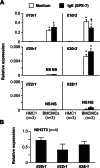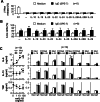IL-10 promotes Th17 cell differentiation by enhancing STAT1-dependent IL-6 production via IgE-stimulated mast cells
- PMID: 39496822
- PMCID: PMC11535472
- DOI: 10.1038/s41598-024-77929-y
IL-10 promotes Th17 cell differentiation by enhancing STAT1-dependent IL-6 production via IgE-stimulated mast cells
Abstract
Mast cells (MCs) are tissue-resident cells of hematopoietic origin that play an important role in host's defense mechanism against nematodes. However, excessive activation of these cells contributes to the development of certain allergic diseases. Immunoglobin E (IgE) is one of the well-known molecules that activate MCs. Even in the absence of specific antigens, the binding of highly cytokinergic IgE to FcεRI on MCs prolongs their survival and induces cytokine production without enhancing their degranulation. In the present study, we examined the effects of the members of the interleukin-10 (IL-10) family of cytokines on IgE-mediated MCs functions. The receptors including Il10r1, Il10r2, and Il20r2, but not Il20r1, Il22r1 or Il28r1, were constitutively expressed in mouse bone marrow cell-derived cultured MCs (BMCMCs), suggesting that IL-10 may influence MCs function. Indeed, we found that only IL-10 could influence upon BMCMCs function; IL-10 enhanced prolongation of survival, promoted IL-6 and/or IL-13 production dependently of STAT1 and STAT3, and suppressed tumor necrosis factor production independently of STAT1 and STAT3 on IgE-stimulated BMCMCs. Moreover, the IL-10-mediated enhancement of IL-6 production by IgE-stimulated BMCMCs promotes Th17 cell expansion. These results suggest that IL-10 has a dual role as an anti-inflammatory and pro-inflammatory cytokine in MCs functions.
Keywords: IL-10; Mast cells; STAT1; STAT3; Th17 cells.
© 2024. The Author(s).
Conflict of interest statement
The authors declare no competing interests.
Figures




References
-
- Kalesnikoff, J. et al. Monomeric IgE stimulates signaling pathways in mast cells that lead to cytokine production and cell survival. Immunity14, 801–811 (2001). - PubMed
-
- Lu-Kuo, J. M., Austen, K. F. & Katz, H. R. Post-transcriptional stabilization by interleukin-1beta of interleukin-6 mRNA induced by c-kit ligand and interleukin-10 in mouse bone marrow-derived mast cells. J. Biol. Chem.271, 22169–22174. 10.1074/jbc.271.36.22169 (1996). - PubMed
-
- Pestka, S. et al. Interleukin-10 and related cytokines and receptors. Annu. Rev. Immunol.22, 929–979. 10.1146/annurev.immunol.22.012703.104622 (2004). - PubMed
MeSH terms
Substances
Grants and funding
LinkOut - more resources
Full Text Sources
Research Materials
Miscellaneous

